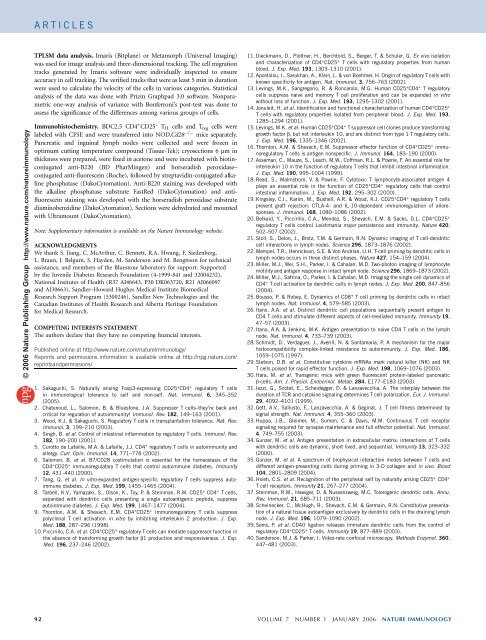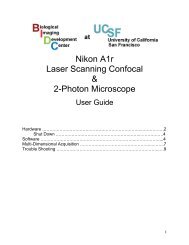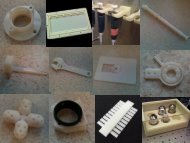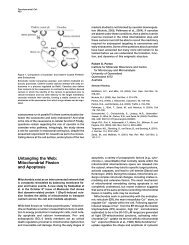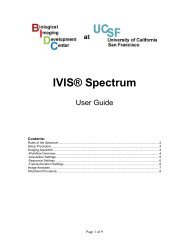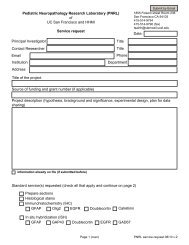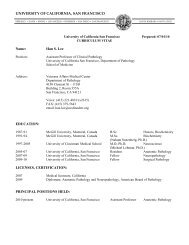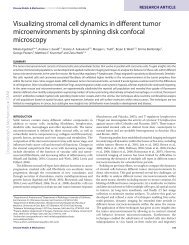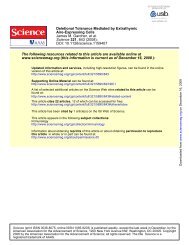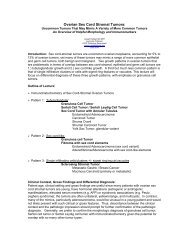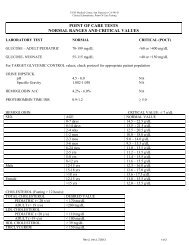Tang et al. Nature Immunology. 2006 - Departments of Pathology ...
Tang et al. Nature Immunology. 2006 - Departments of Pathology ...
Tang et al. Nature Immunology. 2006 - Departments of Pathology ...
You also want an ePaper? Increase the reach of your titles
YUMPU automatically turns print PDFs into web optimized ePapers that Google loves.
ARTICLES<br />
© <strong>2006</strong> <strong>Nature</strong> Publishing Group http://www.nature.com/natureimmunology<br />
TPLSM data an<strong>al</strong>ysis. Imaris (Bitplane) or M<strong>et</strong>amorph (Univers<strong>al</strong> Imaging)<br />
was used for image an<strong>al</strong>ysis and three-dimension<strong>al</strong> tracking. The cell migration<br />
tracks generated by Imaris s<strong>of</strong>tware were individu<strong>al</strong>ly inspected to ensure<br />
accuracy in cell tracking. The verified tracks that were as least 5 min in duration<br />
were used to c<strong>al</strong>culate the velocity <strong>of</strong> the cells in various categories. Statistic<strong>al</strong><br />
an<strong>al</strong>ysis <strong>of</strong> the data was done with Prizm Graphpad 3.0 s<strong>of</strong>tware. Nonparam<strong>et</strong>ric<br />
one-way an<strong>al</strong>ysis <strong>of</strong> variance with Bonferroni’s post-test was done to<br />
assess the significance <strong>of</strong> the differences among various groups <strong>of</strong> cells.<br />
Immunohistochemistry. BDC2.5 CD4 + CD25 – T H cells and T reg cells were<br />
labeled with CFSE and were transferred into NOD.Cd28 / mice separately.<br />
Pancreatic and inguin<strong>al</strong> lymph nodes were collected and were frozen in<br />
optimum cutting temperature compound (Tissue-Tek); cryosections 6 mm in<br />
thickness were prepared, were fixed in ac<strong>et</strong>one and were incubated with biotinconjugated<br />
anti-B220 (BD PharMingen) and horseradish peroxidase–<br />
conjugated anti-fluorescein (Roche), followed by streptavidin-conjugated <strong>al</strong>k<strong>al</strong>ine<br />
phosphatase (DakoCytomation). Anti-B220 staining was developed with<br />
the <strong>al</strong>k<strong>al</strong>ine phosphatase substrate FastRed (DakoCytomation) and antifluorescein<br />
staining was developed with the horseradish peroxidase substrate<br />
diaminobenzidine (DakoCytomation). Sections were dehydrated and mounted<br />
with Ultramount (DakoCytomation).<br />
Note: Supplementary information is available on the <strong>Nature</strong> <strong>Immunology</strong> website.<br />
ACKNOWLEDGMENTS<br />
We thank S. Jiang, C. McArthur, C. Benn<strong>et</strong>t, R.A. Hwang, F. Siedenberg,<br />
L. Braun, J. Belgum, S. Hayden, M. Sanderson and M. Bengttson for technic<strong>al</strong><br />
assistance, and members <strong>of</strong> the Bluestone laboratory for support. Supported<br />
by the Juvenile Diab<strong>et</strong>es Research Foundation (4-1999-841 and 32004232),<br />
Nation<strong>al</strong> Insitutes <strong>of</strong> He<strong>al</strong>th (R37 AI46643, P30 DK063720, R21 AI066097<br />
and AI30663), Sandler–Howard Hughes Medic<strong>al</strong> Institute Biomedic<strong>al</strong><br />
Research Support Program (5300246), Sandler New Technologies and the<br />
Canadian Institutes <strong>of</strong> He<strong>al</strong>th Research and Alberta Heritage Foundation<br />
for Medic<strong>al</strong> Research.<br />
COMPETING INTERESTS STATEMENT<br />
The authors declare that they have no comp<strong>et</strong>ing financi<strong>al</strong> interests.<br />
Published online at http://www.nature.com/natureimmunology/<br />
Reprints and permissions information is available online at http://npg.nature.com/<br />
reprintsandpermissions/<br />
1. Sakaguchi, S. Natur<strong>al</strong>ly arising Foxp3-expressing CD25 + CD4 + regulatory T cells<br />
in immunologic<strong>al</strong> tolerance to self and non-self. Nat. Immunol. 6, 345–352<br />
(2005).<br />
2. Chatenoud, L., S<strong>al</strong>omon, B. & Bluestone, J.A. Suppressor T cells–they’re back and<br />
critic<strong>al</strong> for regulation <strong>of</strong> autoimmunity! Immunol. Rev. 182, 149–163 (2001).<br />
3. Wood, K.J. & Sakaguchi, S. Regulatory T cells in transplantation tolerance. Nat. Rev.<br />
Immunol. 3, 199–210 (2003).<br />
4. Singh, B. <strong>et</strong> <strong>al</strong>. Control <strong>of</strong> intestin<strong>al</strong> inflammation by regulatory T cells. Immunol. Rev.<br />
182, 190–200 (2001).<br />
5. Curotto de Lafaille, M.A. & Lafaille, J.J. CD4 + regulatory T cells in autoimmunity and<br />
<strong>al</strong>lergy. Curr. Opin. Immunol. 14, 771–778 (2002).<br />
6. S<strong>al</strong>omon, B. <strong>et</strong> <strong>al</strong>. B7/CD28 costimulation is essenti<strong>al</strong> for the homeostasis <strong>of</strong> the<br />
CD4 + CD25 + immunoregulatory T cells that control autoimmune diab<strong>et</strong>es. Immunity<br />
12, 431–440 (2000).<br />
7. <strong>Tang</strong>, Q. <strong>et</strong> <strong>al</strong>. In vitro-expanded antigen-specific regulatory T cells suppress autoimmune<br />
diab<strong>et</strong>es. J. Exp. Med. 199, 1455–1465 (2004).<br />
8. Tarbell, K.V., Yamazaki, S., Olson, K., Toy, P. & Steinman, R.M. CD25 + CD4 + Tcells,<br />
expanded with dendritic cells presenting a single autoantigenic peptide, suppress<br />
autoimmune diab<strong>et</strong>es. J. Exp. Med. 199, 1467–1477 (2004).<br />
9. Thornton, A.M. & Shevach, E.M. CD4 + CD25 + immunoregulatory T cells suppress<br />
polyclon<strong>al</strong> T cell activation in vitro by inhibiting interleukin 2 production. J. Exp.<br />
Med. 188, 287–296 (1998).<br />
10. Piccirillo, C.A. <strong>et</strong> <strong>al</strong>. CD4 + CD25 + regulatory T cells can mediate suppressor function in<br />
the absence <strong>of</strong> transforming growth factor b1 production and responsiveness. J. Exp.<br />
Med. 196, 237–246 (2002).<br />
11. Dieckmann, D., Plottner, H., Berchtold, S., Berger, T. & Schuler, G. Ex vivo isolation<br />
and characterization <strong>of</strong> CD4 + CD25 + T cells with regulatory properties from human<br />
blood. J. Exp. Med. 193, 1303–1310 (2001).<br />
12. Apostolou, I., Sarukhan, A., Klein, L. & von Boehmer, H. Origin <strong>of</strong> regulatory T cells with<br />
known specificity for antigen. Nat. Immunol. 3, 756–763 (2002).<br />
13. Levings, M.K., Sangregorio, R. & Roncarolo, M.G. Human CD25 + CD4 + T regulatory<br />
cells suppress naive and memory T cell proliferation and can be expanded in vitro<br />
without loss <strong>of</strong> function. J. Exp. Med. 193, 1295–1302 (2001).<br />
14. Jonuleit, H. <strong>et</strong> <strong>al</strong>. Identification and function<strong>al</strong> characterization <strong>of</strong> human CD4 + CD25 +<br />
T cells with regulatory properties isolated from peripher<strong>al</strong> blood. J. Exp. Med. 193,<br />
1285–1294 (2001).<br />
15. Levings, M.K. <strong>et</strong> <strong>al</strong>. Human CD25 + CD4 + T suppressor cell clones produce transforming<br />
growth factor b, but not interleukin 10, and are distinct from type 1 T regulatory cells.<br />
J. Exp. Med. 196, 1335–1346 (2002).<br />
16. Thornton, A.M. & Shevach, E.M. Suppressor effector function <strong>of</strong> CD4 + CD25 + immunoregulatory<br />
T cells is antigen nonspecific. J. Immunol. 164, 183–190 (2000).<br />
17. Asseman, C., Mauze, S., Leach, M.W., C<strong>of</strong>fman, R.L. & Powrie, F. An essenti<strong>al</strong> role for<br />
interleukin 10 in the function <strong>of</strong> regulatory T cells that inhibit intestin<strong>al</strong> inflammation.<br />
J. Exp. Med. 190, 995–1004 (1999).<br />
18. Read, S., M<strong>al</strong>mstrom, V. & Powrie, F. Cytotoxic T lymphocyte-associated antigen 4<br />
plays an essenti<strong>al</strong> role in the function <strong>of</strong> CD25 + CD4 + regulatory cells that control<br />
intestin<strong>al</strong> inflammation. J. Exp. Med. 192, 295–302 (2000).<br />
19. Kingsley, C.I., Karim, M., Bushell, A.R. & Wood, K.J. CD25 + CD4 + regulatory T cells<br />
prevent graft rejection: CTLA-4- and IL-10-dependent immunoregulation <strong>of</strong> <strong>al</strong>loresponses.<br />
J. Immunol. 168, 1080–1086 (2002).<br />
20. Belkaid, Y., Piccirillo, C.A., Mendez, S., Shevach, E.M. & Sacks, D.L. CD4 + CD25 +<br />
regulatory T cells control Leishmania major persistence and immunity. <strong>Nature</strong> 420,<br />
502–507 (2002).<br />
21. Stoll, S., Delon, J., Brotz, T.M. & Germain, R.N. Dynamic imaging <strong>of</strong> T cell-dendritic<br />
cell interactions in lymph nodes. Science 296, 1873–1876 (2002).<br />
22. Mempel, T.R., Henrickson, S.E. & Von Andrian, U.H. T-cell priming by dendritic cells in<br />
lymph nodes occurs in three distinct phases. <strong>Nature</strong> 427, 154–159 (2004).<br />
23. Miller, M.J., Wei, S.H., Parker, I. & Cah<strong>al</strong>an, M.D. Two-photon imaging <strong>of</strong> lymphocyte<br />
motility and antigen response in intact lymph node. Science 296, 1869–1873 (2002).<br />
24. Miller, M.J., Safrina, O., Parker, I. & Cah<strong>al</strong>an, M.D. Imaging the single cell dynamics <strong>of</strong><br />
CD4 + T cell activation by dendritic cells in lymph nodes. J. Exp. Med. 200, 847–856<br />
(2004).<br />
25. Bousso, P. & Robey, E. Dynamics <strong>of</strong> CD8 + T cell priming by dendritic cells in intact<br />
lymph nodes. Nat. Immunol. 4, 579–585 (2003).<br />
26. Itano, A.A. <strong>et</strong> <strong>al</strong>. Distinct dendritic cell populations sequenti<strong>al</strong>ly present antigen to<br />
CD4 T cells and stimulate different aspects <strong>of</strong> cell-mediated immunity. Immunity 19,<br />
47–57 (2003).<br />
27. Itano, A.A. & Jenkins, M.K. Antigen presentation to naive CD4 T cells in the lymph<br />
node. Nat. Immunol. 4, 733–739 (2003).<br />
28. Schmidt, D., Verdaguer, J., Averill, N. & Santamaria, P. A mechanism for the major<br />
histocompatibility complex-linked resistance to autoimmunity. J. Exp. Med. 186,<br />
1059–1075 (1997).<br />
29. St<strong>et</strong>son, D.B. <strong>et</strong> <strong>al</strong>. Constitutive cytokine mRNAs mark natur<strong>al</strong> killer (NK) and NK<br />
T cells poised for rapid effector function. J. Exp. Med. 198, 1069–1076 (2003).<br />
30. Hara, M. <strong>et</strong> <strong>al</strong>. Transgenic mice with green fluorescent protein-labeled pancreatic<br />
b-cells. Am. J. Physiol. Endocrinol. M<strong>et</strong>ab. 284, E177–E183 (2003).<br />
31. Iezzi, G., Scot<strong>et</strong>, E., Scheidegger, D. & Lanzavecchia, A. The interplay b<strong>et</strong>ween the<br />
duration <strong>of</strong> TCR and cytokine sign<strong>al</strong>ing d<strong>et</strong>ermines T cell polarization. Eur. J. Immunol.<br />
29, 4092–4101 (1999).<br />
32. G<strong>et</strong>t, A.V., S<strong>al</strong>lusto, F., Lanzavecchia, A. & Geginat, J. T cell fitness d<strong>et</strong>ermined by<br />
sign<strong>al</strong> strength. Nat. Immunol. 4, 355–360 (2003).<br />
33. Huppa, J.B., Gleimer, M., Sumen, C. & Davis, M.M. Continuous T cell receptor<br />
sign<strong>al</strong>ing required for synapse maintenance and full effector potenti<strong>al</strong>. Nat. Immunol.<br />
4, 749–755 (2003).<br />
34. Gunzer, M. <strong>et</strong> <strong>al</strong>. Antigen presentation in extracellular matrix: interactions <strong>of</strong> T cells<br />
with dendritic cells are dynamic, short lived, and sequenti<strong>al</strong>. Immunity 13, 323–332<br />
(2000).<br />
35. Gunzer, M. <strong>et</strong> <strong>al</strong>. A spectrum <strong>of</strong> biophysic<strong>al</strong> interaction modes b<strong>et</strong>ween T cells and<br />
different antigen-presenting cells during priming in 3-D collagen and in vivo. Blood<br />
104, 2801–2809 (2004).<br />
36. Hsieh, C.S. <strong>et</strong> <strong>al</strong>. Recognition <strong>of</strong> the peripher<strong>al</strong> self by natur<strong>al</strong>ly arising CD25 + CD4 +<br />
T cell receptors. Immunity 21, 267–277 (2004).<br />
37. Steinman, R.M., Hawiger, D. & Nussenzweig, M.C. Tolerogenic dendritic cells. Annu.<br />
Rev. Immunol. 21, 685–711 (2003).<br />
38. Scheinecker, C., McHugh, R., Shevach, E.M. & Germain, R.N. Constitutive presentation<br />
<strong>of</strong> a natur<strong>al</strong> tissue autoantigen exclusively by dendritic cells in the draining lymph<br />
node. J. Exp. Med. 196, 1079–1090 (2002).<br />
39. Serra, P. <strong>et</strong> <strong>al</strong>. CD40 ligation releases immature dendritic cells from the control <strong>of</strong><br />
regulatory CD4 + CD25 + Tcells.Immunity 19, 877–889 (2003).<br />
40. Sanderson, M.J. & Parker, I. Video-rate confoc<strong>al</strong> microscopy. M<strong>et</strong>hods Enzymol. 360,<br />
447–481 (2003).<br />
92 VOLUME 7 NUMBER 1 JANUARY <strong>2006</strong> NATURE IMMUNOLOGY


